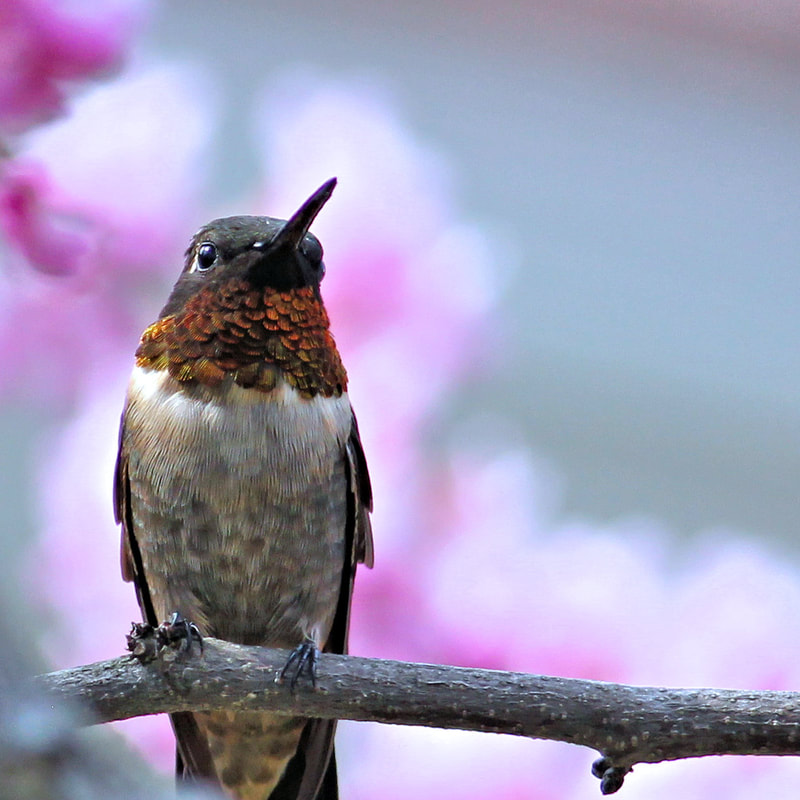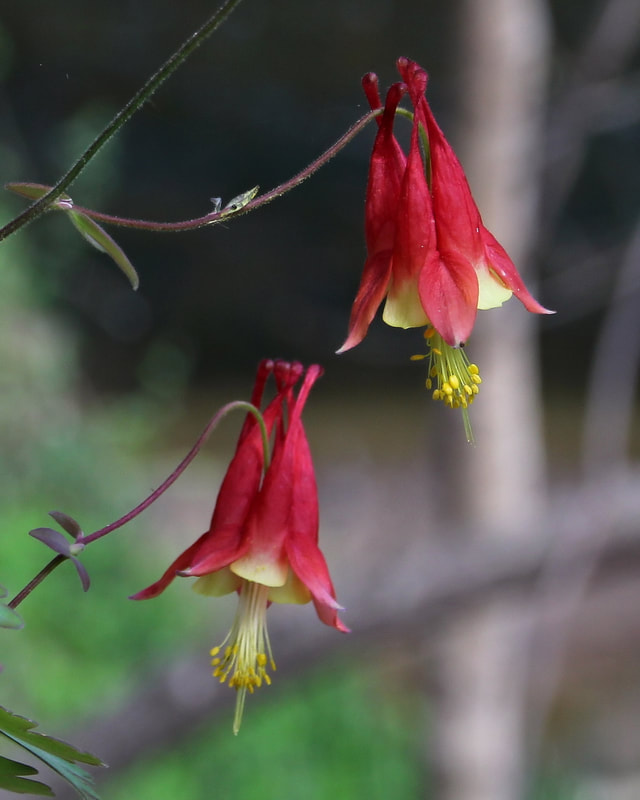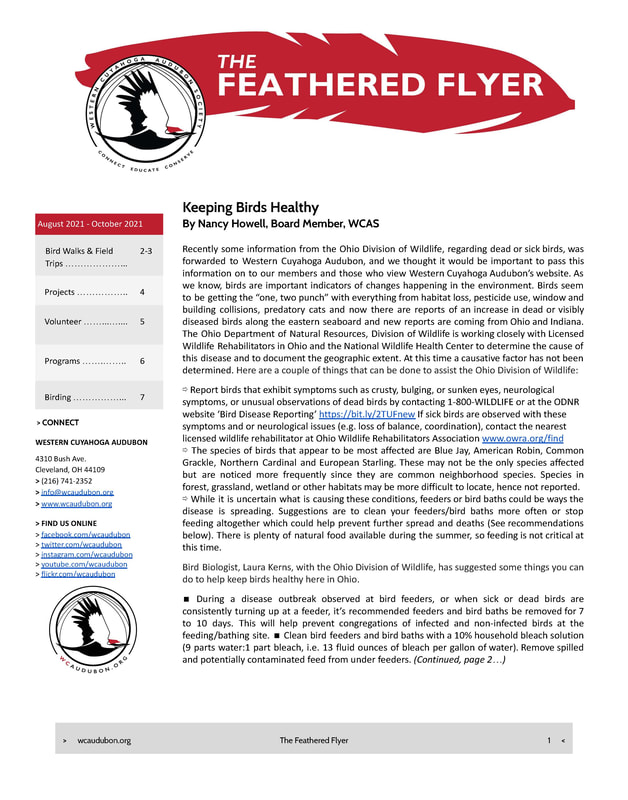This mid-spring flower’s occurrence coincides with the arrival of another of Nature’s most beloved flying jewels: the ruby-throated hummingbird.
Ohio's Elegant Spring Columbine
By Patti Donnellan, CIG, OCVN Perhaps one of the most elegant of Ohio’s spring wildflowers is Columbine. “Our columbine is at all times and in all places one of the most exquisitely beautiful of flowers.” It is difficult to argue with early American naturalist John Burroughs (1837-1921) on that. However, don’t let Columbine’s delicate and tender appearance deceive you. It can grow in some of the most inhospitable spots in your yard and in the wild. I personally have witnessed it growing right on top of limestone rocks, as well as in cracks in my driveway. These lovely nodding blossoms can appear in shady corners and creep along walls, while adding color to dappled garden beds with pops of red and yellow. This mid-spring flower’s occurrence coincides with the arrival of another of Nature’s most beloved flying jewels: the ruby-throated hummingbird.
Its botanical name Aquilegia, is as mysterious as the flowers themselves. It could be derived from the Latin aquila, “eagle” due to the long nectar-filled spurs that resemble the talons of the large raptor, or aquilegus, a Greek jar with a pointed base so it could be buried in the ground to keep the liquid contents cool. The common name, Columbine, is a reference to another beloved bird – the dove (genus Columba).
This mid-spring flower’s occurrence coincides with the arrival of another of Nature’s most beloved flying jewels: the ruby-throated hummingbird. Eastern Columbine, Aquilegia canadensis, is the only columbine east of the Great Plains and, not coincidentally, found throughout the entire range of the ruby-throated hummingbird. All other species of Columbines are a more open structure and pollinated by insects. Also no other species are red in color, nor do the other species hang upside down like our eastern species. The ruby-throated hummingbird and Eastern Columbine truly are a couple of the ages, like mythological Psyche living atop a rocky mountain with only Cupid being a suitable partner. Eastern columbine does have a few other even smaller species that utilize it, including the larva of the Columbine duskywing (Erynnis lucilius) who, after eating its fill, rolls up a leaf like a sleeping bag and naps within. I can’t think of a lovelier place to sleep off a hearty meal! These gorgeous flowers come in many varieties, but each is known for its contrasting colors and multiple layers of intricate petals. During the Renaissance, this flower was associated with the Holy Spirit and the sorrows of the Virgin Mary and was often depicted in blue or white in ancient manuscripts. While columbines are typically considered a North American group, the genus Aquilegia actually originated in eastern Europe and central Asia and contain more than 50 species worldwide. DNA analyses have determined two European species and one Asian species form the ancestral group from which all other species of Aquilegia evolved. One species of Columbine expanded its range across the Bering land bridge connecting Asia and North America during the last glacial period 10,000 to 40,000 years ago, resulting in the 13 species that grace our American landscapes today. In addition to our eastern red species, many North American species appear in shades of blue and white – like the colors of our national flag. “A woodland walk, a quest for river-grapes, a mocking thrush, a wild rose or rock-living columbine, salve my worst wounds.” ~ Ralph Waldo Emerson
Continuing on the Americana theme, Columbine was considered a candidate for our national flower in the early parts of the 20th century; however, it also had the reputation as the bearer of bad news: If a woman was gifted a bouquet of Columbine, it signified an unfaithful lover or spouse. Going back even farther into American history, Meskwaki Indians would add the ripened seed capsules with tobacco to improve the smell, believing that the smoke created a “love perfume”, in hopes of attracting a mate.
Other American Indian tribes consumed the roots and/or seeds to treat headaches and fever. Columbine should NOT be used medicinally, though, as it contains toxins that will result in larger ailments than just a headache. If all these attributes don’t remind you of the resilience, toughness, and beauty of America, then nothing will! Enjoy this spring wildflower in your yard to brighten up those dark spots where not much else can grow and you, just as Ralph Waldo Emerson once said of Columbine, can salve your worst wounds with its graceful beauty.
Photography Credits: (top) Ruby-throated Hummingbird (Archilochus colubris), (bottom left and right) Wild Red Columbine (Aquilegia canadensis) photographed in southern Ohio, April 2017 by Tom Fishburn, and (center) by David Longfellow.
Contributors
Patti Donnellan grew up in Cleveland's western suburbs, exploring the woods, fields, and waterways near her home. Her love of the outdoors was enhanced by her parents, who taught and encouraged outdoor activities like fishing, camping, tree climbing, wildlife identification, composting and gardening. Her love of living things led to many years as a veterinary technician, an education in Wildlife and Fisheries Science, and a career as a professional naturalist. She is a Certified Interpretive Guide from the National Association for Interpretation and Ohio Certified Volunteer Naturalist. Currently, Patti serves the community as the Sustainability Coordinator for the City of Cleveland, leading rain barrel workshops, assisting with the Cleveland Tree Plan, and helping guide residents to a more sustainable way of living. She can be reached at [email protected]

Tom Fishburn got interested in birding in 1980 inspired by two avid birding friends in New Jersey. In 2006 he moved to Ohio not expecting how wonderful the birding and the birding community is here. Tom only started with photography about ten years ago. Eventually, his interests grew to include butterflies, dragonflies, and wildflowers.
Make A Donation to Western Cuyahoga Audubon. Your gifts guarantee chapter activities, programs and research continues to reach members and connect birding conservationists around the world. Use our safe and secure PayPal payment button below to make a donation of any amount you choose. All donations are gratefully received.
Comments
|
Story BlogThe Feathered Flyer blog publishes human interest stories about birding and habitat conservation. After watching, ‘My Painted Trillium Quest' by Tom Fishburn, Kim Langley, WCAS Member said, “Wonderful! It was a lift just knowing that such a site exists and is being protected!”
Media LibrariesQuarterly NewsletterSTORIESPodcastsWCAS is a proud member of The Council of Ohio Audubon Chapters (COAC) and promotes chapter development by sharing the best practices, brainstorming solutions to common problems, and building relationships in workshops and retreats. Subscribe
VideosYouth
Advocacy
Clean Energy
Reporting
Awards
Volunteerism
Take ActionResourcesBlogsArchives
October 2023
Categories
All
|
EDUCATENews Blog
Monthly Speakers Field Reports Bird Walk Reports Christmas Bird Count-Lakewood Circle Media Library Newsletter Archive Education Resources STORE |
Western Cuyahoga Audubon Society
4310 Bush Avenue Cleveland, Ohio 44109 [email protected] Western Cuyahoga Audubon Society is a 501(c)(3) nonprofit organization. Your donation is tax-deductible. The tax ID number is: 34-1522665. If you prefer to mail your donation, please send your check to: Nancy Howell, Western Cuyahoga Audubon Treasurer, 19340 Fowles Rd, Middleburg Hts, OH 44130. © 2020 Western Cuyahoga Audubon Society. All rights reserved. Privacy Policy | Terms of Use | Legal | Store Shipping Rates | Site Map |













 RSS Feed
RSS Feed

